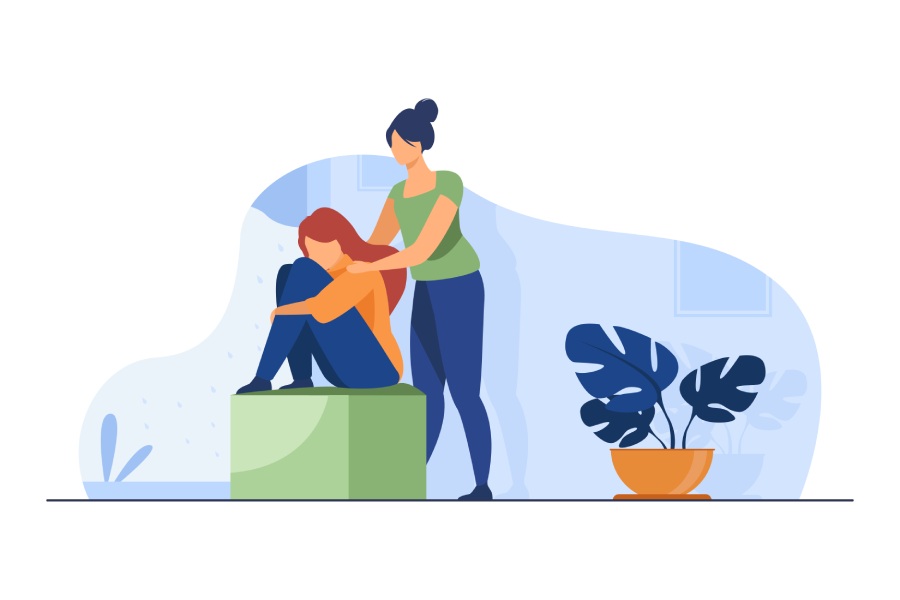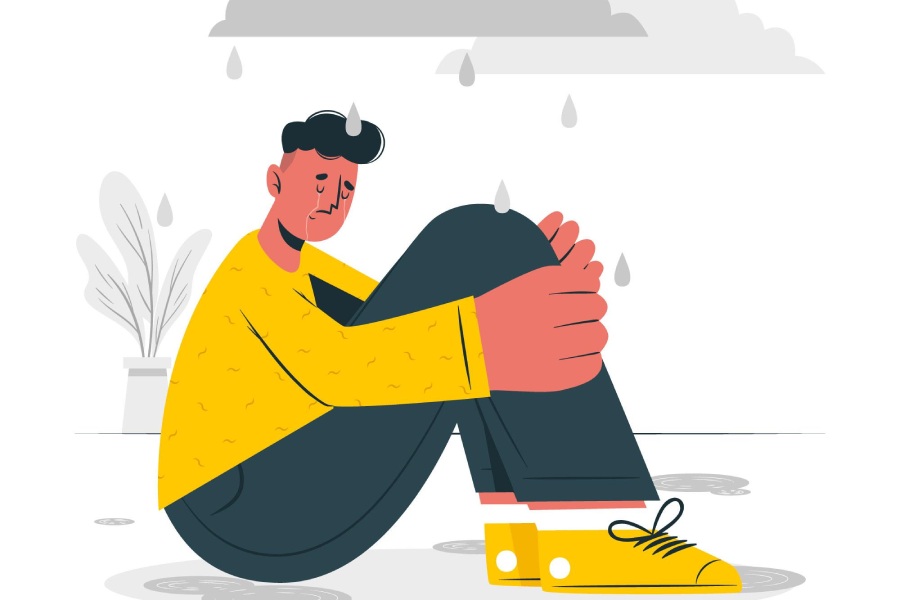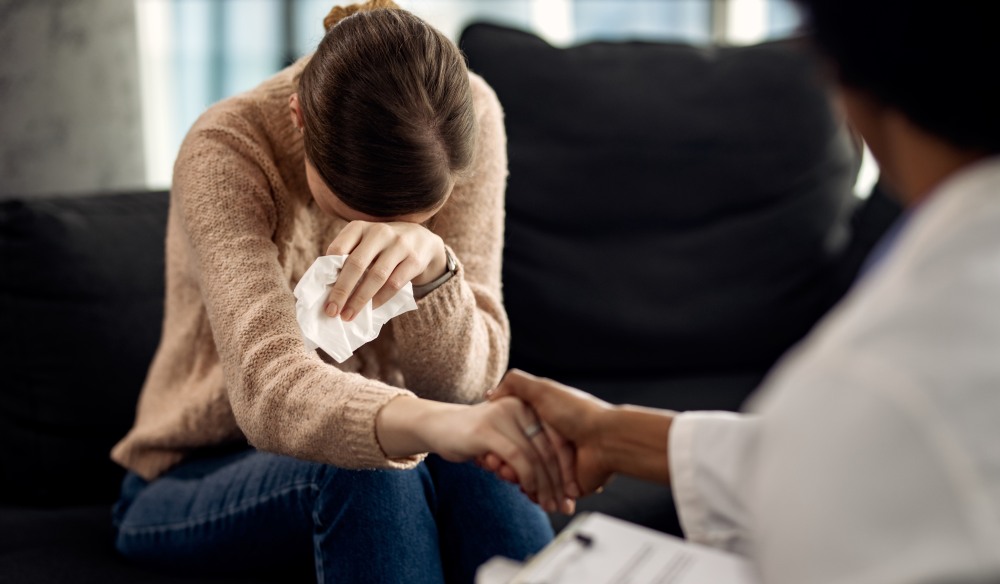Our lives tend to be a roller coaster of emotions, and we often have normal fluctuations in our moods that come and go. However, when an individual’s mood begins to affect the other areas of their life and day-to-day functioning, it might become a problem. Mood disorders can potentially lead to tragic consequences, thus it is of great importance to develop a thorough understanding of the phenomenon (Ciccarelli, White & White, 2022).
Mood disorders are characterized by extreme changes in mood that disrupt daily life activities. It is a mental health condition that primarily affects an individual’s emotional state. Mood disorders can be relatively mild or moderate (straying only a short distance from the average), or they can be extreme (existing on the other end of the spectrum). The highs are higher, their lows are lower, and they spend more time in these states than most people.
Depression is a part of these mood disorders. The experience of depression is feeling like falling into a deep, dark hole that one cannot climb out of. It influences the way one interprets events, how see yourself, and how you see others.
Join us on this journey as we navigate through the complex labyrinth of depression.
What is Depression?
Depression is a common and serious medical illness that negatively affects how you feel, the way you think, and how you act.
When a deeply depressed mood comes on suddenly and either seems to be too severe for the circumstances or exists without any external causes for sadness, it is called major depressive disorder (MDD). People suffering from depression experience truly profound unhappiness, which they experience most of the time. They also report that they’ve lost interest in the usual pleasures of life (eating, sex, hobbies, sports, etc). They may also experience feelings of tiredness, experience changes in their sleep patterns, experience significant weight changes, have trouble concentrating, and experience excessive amounts of guilt or feelings of worthlessness. Most of these symptoms occur every day and last for the better part of the day.
Some people suffering from depression may have thoughts of death or suicide including suicide attempts. The most serious outcome for a person suffering from depression is death by suicide. (Barlow & Durand, 2015).
Depressive disorders encompass a range of conditions, including disruptive mood dysregulation disorder, major depressive disorder, persistent depressive disorder (dysthymia), premenstrual dysphoric disorder, substance/medication-induced depressive disorder, depressive disorder due to another medical condition, other specified depressive disorder, and unspecified depressive disorder. (APA, 2013).

Let’s take a closer look at some of the signs and symptoms that may indicate the presence of depression in our lives:
- Experiencing truly profound unhappiness, which they experience most of the time, nearly every day.
- Losing interest in the usual pleasures of life (eating, sex, hobbies, sports, etc).
- Experiencing feelings of tiredness.
- Experiencing changes in their sleep patterns.
- Experiencing significant weight changes.
- Having trouble concentrating, and being indecisive.
- Experiencing psychomotor agitation nearly every day
- Experiencing excessive amounts of guilt or feelings of worthlessness.
- Continuously thinking about death, experiencing persistent thoughts of suicide with or without a defined plan, or having attempted suicide or formulated a specific plan for taking one’s own life.
Most of these symptoms occur every day and last for the better part of the day. These symptoms significantly affect a person’s ability to function well in the important areas of their life. (APA, 2013).
As we proceed further, let us understand the cycle of depression
The cycle of depression is a repetitive pattern where various factors work together, making depressive episodes last and become more intense.
The cycle usually begins with stress, which in turn leads to negative thoughts, powerful emotions, and the presence of physical symptoms (Hammen, 2005; Monroe et al., 2009). For example, the loss of a job can result in an individual feeling that they are inadequate, which can lead to strong emotions such as sadness or hopelessness.
This cycle can also lead to other physical manifestations such as changes in appetite, or changes in sleep patterns. As an individual undergoes these psychological and physical factors, social factors can also play an important role – continuing the example – the experience of losing a job can lead an individual to withdraw themselves from social events and instead isolate themselves from their friends and family.
Thus this reinforcing loop becomes more intensive with the combination of all these factors, creating a vicious cycle (Centre for Clinical Interventions, 2019).
Causes of Depression
Different psychological and biological factors contribute to the development of depression.
Psychological Factors of Depression
1. Stressful and Traumatic Life Events
Experiencing stressful or traumatic life events such as the loss of a loved one, financial difficulties, troubled relationships, going through an accident/injury, being the victim of a crime, etc. can contribute to the development of depression.
Also Read: How to Manage Depression at Workplace
2. Personality Factors
Certain personality traits, such as low self-esteem, a tendency to worry excessively, sensitivity, perfectionism, negative thought patterns, impulsivity, etc. can contribute to the development of depression.
3. Interpersonal Relationships
Facing difficulties in interpersonal relationships, isolation from society, lack of social support, conflicted relationships, bullying/harassment, etc. can contribute to the development of depression.
Biological Factors of Depression
1. Genetics
Having a family history of depression can increase the likelihood of an individual developing the disorder. Specific genetic variations or combinations of genes may increase the vulnerability of individuals to depression. (Levinson, 2006, 2009).
2. Hormonal Changes
Fluctuations in hormones, especially during the period of puberty, pregnancy, and menopause can contribute to the development of depression (Southwick et al., 2005; Thase, 2009a).
3. Neurotransmitter Imbalance
Neurotransmitters play a role in regulating our mood. Imbalances in these neurotransmitter levels, especially serotonin, norepinephrine, and dopamine, can lead to the development of depressive symptoms (Southwick et al., 2005; Thase, 2009a).
4. Brain Structure and Function
Structural and functional changes in key brain regions such as the hippocampus and the prefrontal cortex have been observed in individuals with depression.
5. Sleep and Circadian Rhythms
The circadian rhythm is the body’s natural internal process that regulates the sleep-wake cycle, and repeats roughly every 24 hours. Experiencing disruptions in sleep patterns and circadian rhythms are not only symptoms but also contributing factors in depression. These irregularities influence mood-regulating neurotransmitters and the hypothalamic-pituitary-adrenal axis (HPA-Axis), which further contributes to the complexity of depression.
(Hooley et al., 2017; Barlow & Durand, 2015).
Now that we’ve had a glimpse into the intricacies, let us take a look at how we can support individuals with depression
The treatment of depression often involves a combination of psychological therapies and medications to address the complex nature of the condition.

Psychological Treatments For Depression
- Cognitive Behavioral Therapy
Cognitive Behavioral Therapy (CBT) is a psychotherapeutic approach that helps individuals recognize and modify negative thought patterns and behaviors that are associated with psychological distress under the guidance of a skilled therapist in India and around the globe. It is widely utilized for conditions like depression and anxiety. CBT emphasizes practical skill-building, goal-setting, and restructuring cognitive patterns to improve emotional well-being. CBT can be used to treat depression by helping individuals identify negative thought patterns, challenge distorted thoughts, activate certain behaviors, develop adaptive coping strategies and skills, help them set realistic goals, monitor and restructure core beliefs, promote self-efficacy, and prevent relapse (Beck, 2011).
- Interpersonal Psychotherapy
Interpersonal Psychotherapy (IPT) is a structured and time-limited psychotherapeutic approach typically lasting 15-20 sessions. It focuses on resolving interpersonal issues as a means of addressing and alleviating mood disorders – particularly depression. IPT identifies and resolves life stressors, focusing on four main areas- navigating role disputes, coping with relationship losses, establishing new connections, and enhancing social skills to foster and maintain meaningful relationships. The therapy aims to improve overall well-being by addressing the impact of interpersonal dynamics on mental health (Barlow & Durand, 2015).
Medications
Medication treatments for depression typically involve the use of medications – specifically antidepressants. These medicines work by affecting certain chemicals in the brain to alleviate symptoms of depression. Various types of antidepressants are available, and the optimal choice is determined based on several factors such as the individual’s symptoms and health history.
It is of utmost importance to consult appropriate healthcare professionals to find the right medication and dosage for you, keeping potential side effects in mind (Barlow & Durand, 2015).
What you can do on your part to support someone with depression
- Create a safe and non-judgmental environment
- Actively listen to what they have to say
- Respect their boundaries
- Educate yourself on the intricacies of depression
- Spend quality time with them by engaging in activities and hobbies they enjoy.
- Be patient and understanding
- Encourage seeking professional help
(Choenarom et al., 2005).
To conclude, depression is an intricate mental health condition, that goes beyond mere sadness, impacting other areas of one’s life. It is crucial to recognize the warning signs of depression and seek help immediately if you or your loved ones are experiencing these symptoms. It is also essential to support individuals going through depression by creating a safe, empathetic, and non-judgmental environment that fosters open communication.
Thus as a community, it is our role to break the walls of stigma associated with depression and foster understanding to pave the way for a brighter future for all.
References
American Psychiatric Association. Diagnostic and Statistical Manual of Mental Disorders (DSM-5©). American Psychiatric Pub, Washington, DC (2013).
Barlow, D. H., Durand, V. M. (2015). Abnormal Psychology, An Integrative Approach (Seventh Edition).
Beck, J. S. (2011). Cognitive behavior therapy: Basics and beyond (2nd ed.). Guilford Press.
Centre for Clinical Interventions, (2019). The Vicious Cycle of Depression. https://www.cci.health.wa.gov.au/~/media/CCI/Mental-Health-Professionals/Depression/Depression—Information-Sheets/Depression-Information-Sheet—04—Vicious-Cycle-for-Depression.pdf
Choenarom, C., Williams, R. A., & Hagerty, B. M. (2005). The Role of Sense of Belonging and Social Support on Stress and Depression in Individuals With Depression. Archives of Psychiatric Nursing, 19(1), 18–29. https://doi.org/10.1016/J.APNU.2004.11.003
Ciccarelli, S. K., White, N. J., Misra, G. (2022) Psychology, Fifth Edition.
Hammen, C. (2005). Stress and depression. In Annu. Rev. Clin. Psychol. (Vol. 1, pp. 293–319). Palo Alto, CA: Annual Reviews.
Hooley, J.M., Butcher, J, N., Nock, M., & Mineka, S. (2017). Abnormal Psychology, 17th Edition.
Kellner, C. H., Greenberg, R. M., Murrough, J. W., Bryson, E. O., Briggs, M. C., & Pasculli, R. M. (2012). ECT in Treatment-Resistant Depression. American Journal of Psychiatry, 169(12), 1238–1244.
Levinson, D. F. (2006). The genetics of depression: A review. Biol. Psychiatry, 60(2), 84–92.
Levinson, D. F. (2009). Genetics of major depression. In I. H. Gotlib & C. L. Hammen (Eds.), Handbook of depression (2nd ed., pp. 165–86). New York: Guilford Press.
Monroe, S. M., Slavich, G. M., & Georgiades, K. (2009). The social environment and life stress in depression. In I. H. Gotlib & C. L. Hammen (Eds.), Handbook of depression and its treatment (2nd ed., pp. 340–60). New York: Guilford Press.
Southwick, S. M., Vythilingam, M., & Charney, D. S. (2005). The psychobiology of depression and resilience to stress: Implications for prevention and treatment. Annu. Rev. Clin. Psych., 1(1), 255–91.
Thase, M. E. (2009a). Neurobiological aspects of depression. In I. Gotlib & C. Hammen (Eds.), Handbook of depression (2nd ed.). New York: Guilford Press.

